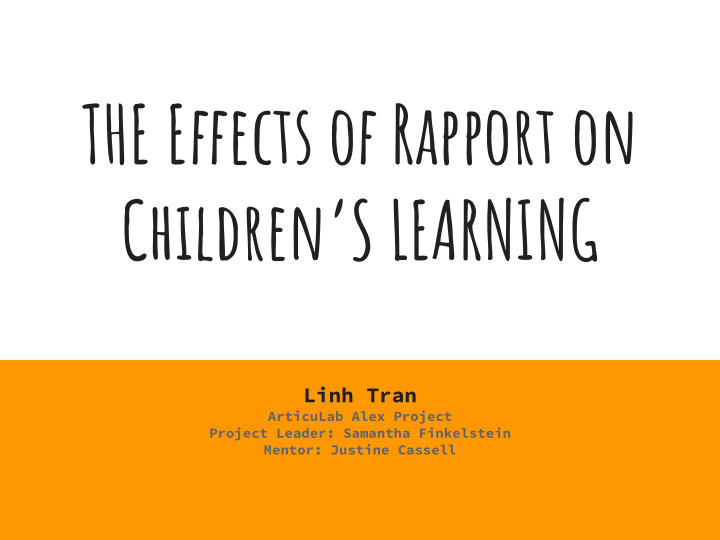



THE Effects of Rapport on Children’S LEARNING Linh Tran ArticuLab Alex Project Project Leader: Samantha Finkelstein Mentor: Justine Cassell
PROBLEM ● We don’t know how to best measure rapport and the impacts it might have on learning ? ● By better understanding how to measure it we could better improve the way we design education interventions. 2
MOTIVATION Most studies interprets rapport using cross sectional rather than ● longitudinal methods (Ambady et al. 2000). Utopy is likelihood of increasing change in rapport over time and allows ● use to see a fine-grain analysis of how increasing rapport correlates learning (Sinha 2017, Madaio 2017). 3
Research Question How does average rapport vs. utopy (change in rapport over time) give us a better understanding of the relationship between rapport and learning ? 4
Hypotheses Existing methods might not be enough to understand impact ● of rapport on student’s learning therefore utilizing both average rapport and utopy methods will allow us to see a clearer picture of the relationships ( Tickle & Rosenthal 1990, Ambady et al. 2000, Sinha 2017, Madaio 2017) Dialect might influence the relationship between ● reasoning and rapport because students might reason more when they are talking with someone with who speaks in a dialect they are most familiar with. ( Goodman 1965; Charity et. al 2004; Levine 2011). 5
METHOD ~20 minutes 30s 1 2 3 4 5 6 7 30 AAVE Speaking Kids (Finkelstein 2016) Thin Slice Rapport Rating (Ambady& Rosenthal 1992; Sinha & Cassell 2015) 6
VARIABLES Utopy: Likelihood of increase in rapport from one time slice to the next (Sinha 2017). Average Rapport : Averaging the rapport for the entire interaction for each student. Total Reasoning: Percentage of a child talk that is relevant towards supporting their claim (Finkelstein 2016). 7
AVERAGE RAPPORT RESULTS 8
Utopy results 9
10
11
12
13
14
Conclusion ● Kids with the code-switching agent experiences more rapport under the teacher task. ● Kids with code-switching agent have higher post-reseasong gains. ● Higher average rapport with the teacher task leads to more post- reasoning improvement. ● There is no moderation of condition (the relationship between rapport and reasoning is true, no matter what condition you’re in) 15
Conclusion ● Kids with the code-switching agent experiences more rapport under the teacher task. ● Kids with code-switching agent have higher post-reseasong gains. ● Higher average rapport with the teacher task leads to more post- reasoning improvement. ● There is no moderation of condition (the relationship between rapport and reasoning is true, no matter what condition you’re in) ● By looking at average rapport and utopy together , we were able to see that utopy was a good predictor of reasoning for low- average rapport student, and a bad predictor of reasoning for high average rapport students 16
Implications and Future works ● Implication: build technologies that promote high Utopy up until a certain average rapport state, then focus on maintaining rapport, not continuing to build it ● More data analysis: ● Experiment there is relationship with other variables that measures learning (science discourse) ● Investigate how regulate/maintain a healthy amount of rapport? 17
Thank you Dr. Justine Cassell Samantha Finkelstein ArticuLab Members DREU Program
References ● Canfield, J., & Wells, H. C. (1976). 100 Ways to Enhance Self-Concept in the Classroom: A Handbook for Teachers and Parents. ● Frisby, B. N., & Myers, S. A. (2008). The Relationships among Perceived Instructor Rapport, Student Participation, and Student Learning Outcomes. Texas Speech Communication Journal , 33 (1). ● Goodman, K. S. (1965). Dialect barriers to reading comprehension. Elementary English , 853-860. ● Charity, A. H., Scarborough, H. S., & Griffin, D. M. (2004). Familiarity with school English in African American children and its relation to early reading achievement. Child development , 75 (5), 1340-1356. ● Levine, G. S. (2011). Code choice in the language classroom . Multilingual Matters. ● Moore, D. (2002). Code-switching and learning in the classroom. International journal of bilingual education and bilingualism , 5 (5), 279-293. ● Van Lier, L. (1988). The classroom and the language learner: Ethnography and second-language classroom research . London: Longman. ● Ambady, N., Bernieri, F. J., & Richeson, J. A. (2000). Toward a histology of social behavior: Judgmental accuracy from thin slices of the behavioral stream. Advances in experimental social psychology , 32 , 201-271. ● Madaio, M., Cassell, J., Ogan, A. (2017). The Impact of Peer Tutors’ Use of Indirect Feedback and Instructions. In Proceedings of the 12th International Conference on Computer-Supported Collaborative Learning ● Sinha, T. Cognitive Correlates of Rapport Dynamics in Longitudinal Peer Tutoring. ● Sinha, T., & Cassell, J. (2015, November). We click, we align, we learn: Impact of influence and convergence processes on student learning and rapport building. In Proceedings of the 1st Workshop on Modeling INTERPERsonal SynchrONy And infLuence (pp. 13-20). ACM. ● Okita, S. Y. (2014). Learning from the folly of others: Learning to self-correct by monitoring the reasoning of virtual characters in a computer-supported mathematics learning environment. Computers & Education , 71 , 257-278. ● Koedinger, K. R., Anderson, J. R., Hadley, W. H., & Mark, M. A. (1997). Intelligent tutoring goes to school in the big city. ● Tickle-Degnen, L., & Rosenthal, R. (1990). The nature of rapport and its nonverbal correlates. Psychological inquiry , 1 (4), 285-293. ● Vygotsky, L. (1978). Interaction between learning and development. Readings on the development of children , 23 (3), 34-41. ● Clark, K. B. (1989). Dark ghetto: Dilemmas of social power . Wesleyan University Press. ● Ladson-Billings, G. (2009). The dreamkeepers: Successful teachers of African American children . John Wiley & 19 Sons. ● P. Dillenbourg. Orchestration Graphs. EPFL press, 2015.
Recommend
More recommend